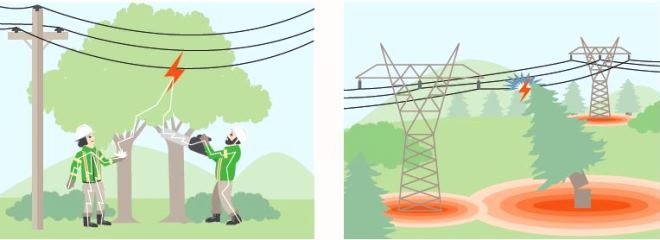Planting & logging near Rights of Way

Tree limits depend on height, voltage of power lines
Landscaping within the rights of way is restricted to low growing trees, shrubs and plants. The maximum allowable height for vegetation, at maturity, depends on the height and voltage of the power line.
We maintain, and remove when necessary, trees and plants that grow around our facilities and power lines in order to keep your service reliable and our works secure.
When planting outside the ROW, we recommend not planting anything that will grow to be very tall, or that has weak root systems that might be prone to falling on power lines or structures. We call these “hazard trees” and we have the right to remove them from under and around our power lines.
Planting near power lines
While we restrict trees in our ROW, we do allow for some low-lying vegetation and other ecological enhancements, such as pollinator fields. Pollinators are an integral part of a healthy ecosystem and are important to food production.
We support pollinator-friendly habitat and encourage the creation of pollinator fields in our ROWs, in consultation with us. To ensure system operation and public safety, please contact us with your plans for the pollinator corridor.
Read our guide for planting near power lines [PDF, 4.6 MB]
Logging near power lines
Logging close to power lines can cause outages, fire hazards and hazardous conditions for the public, logging crews and our crews. Trees that could fall on or near power lines must only be felled under the supervision of a certified utility arborist with current BC Hydro safety certification.
If you're planning to log in proximity to our power lines, contact us before starting operations. We’ll identify any safety concerns and discuss options for prevention. This is a requirement within WorkSafeBC Regulation section 19.30. To reach our vegetation management team, call 1 800 BCHYDRO or 1 800 224 9376.
If any of your operations occur on our statutory right of way (SRW) or cross the SRW (in cases of hauling or skidding logs, for example), please contact our properties team at least three months before logging begins. To reach our properties team, call 1 800 667 1517 or email properties.helpdesk@bchydro.com.
Activities such as high lead logging and helicopter logging near power lines come with added safety considerations, such as transmission of electrical current through equipment. These issues must be discussed and addressed with a member of our team before any work begins.
Other safety tips and regulations
- Don't leave edge trees within a tree length of the right of way. They can fall onto the lines.
- Storing logs isn't permitted on the SRW.
- Debris and slash burning isn't permitted on the SRW.
Property owners and our crews play an important role when it comes to keeping service wires clear of trees and plants. Learn more about maintaining vegetation around power lines.